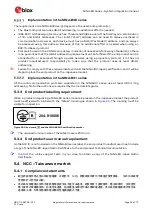
NINA-B3 series - System integration manual
UBX-17056748 - R13
Regulatory information and requirements
Page 50 of 72
C1-Public
☞
Having a separation distance of minimum 10 mm between the user and/or bystander and the
antenna and /or radiating element ensures that the maximum output power of NINA-B3 is below
the SAR test exclusion limits presented in KDB 447498 D01v06 (US market limits).
☞
Having a separation distance of minimum 15 mm between the user and/or bystander and the
antenna and /or radiating element ensures that the output power (e.i.r.p.) of NINA-B3 is below the
SAR evaluation Exemption limits defined in RSS-102 issue 5 (Canadian market limits).
5.2.3
Antenna selection
⚠
For NINA-B301 and NINA-B311, the
Reference design for external antennas (U.FL connector)
must be followed to comply with the NINA-B30/NINA-B31 FCC/IC modular approval. Use only
those antennas that have been authorized for use with NINA-B3. See also
☞
u-blox has provided these pre-approved antennas and reference design to enable quick time to
market, but it is possible and encouraged for customers to add their own antennas and connector
designs. These must be approved by u-blox and in some cases tested.
support for more information about this process.
5.2.4
IEEE 802.15.4 channel map limitation
The 2.4 GHz band used by 802.15.4 communications is segmented into 16 channels, ranging from
channel 11 at 2405 MHz to channel 26 at 2480 MHz, with 5 MHz channel spacing. Due to the wide
spectral properties of the 802.15.4 signal, the use of channel 26 results in too much power being
transmitted in the FCC restricted band starting at 2483.5 MHz. As a result, channel 26 must not be
used on the US/Canadian market.
Implementation in NINA-B31 series
IEEE 802.15.4 is currently not supported in the u-connectXpress software. No additional effort is
needed.
Implementation in NINA-B30 series
Integrators of the open CPU variant of the NINA-
B3 series will have to make a “change in FCC ID” filing
to inherit the test results of the u-blox FCC compliance tests. In this filing process it must be made
clear that the software application has been limited to not use channel 26, and that it cannot be
‘unlocked’ by an end user. It should not be possible for an end user to change the software on the
module to any unauthorized or modified software that allows the use of 802.15.4 channel 26.
Typically, the SWD interface on the NINA-B30 module, which allows full access to all registers and
code space, must be made unavailable to end users.
5.2.5
Change in ID/Multiple Listing process
☞
A Change in ID can be done only for the NINA-B30 series.
The open CPU feature of the NINA-B30 series allows customers to create their own software
applications using the NINA-B3 hardware. This software will have full control of radio parameters, and
it is possible to configure the radio in a way that it will be non-compliant with the FCC regulatory
requirements.
For any product including an FCC/ISED approved radio device, it will be the sole responsibility of the
FCC/ISED ID holder, in this case u-blox, to ensure that the product complies with the FCC radio
regulations. Since the software applications created by integrators of the NINA-B30 series cannot be
controlled by u-blox, the module integrator will have to take over this responsibility. This process is
known as a
“
change in
ID”
in the US and
“
multiple
listing”
in Canada.
















































